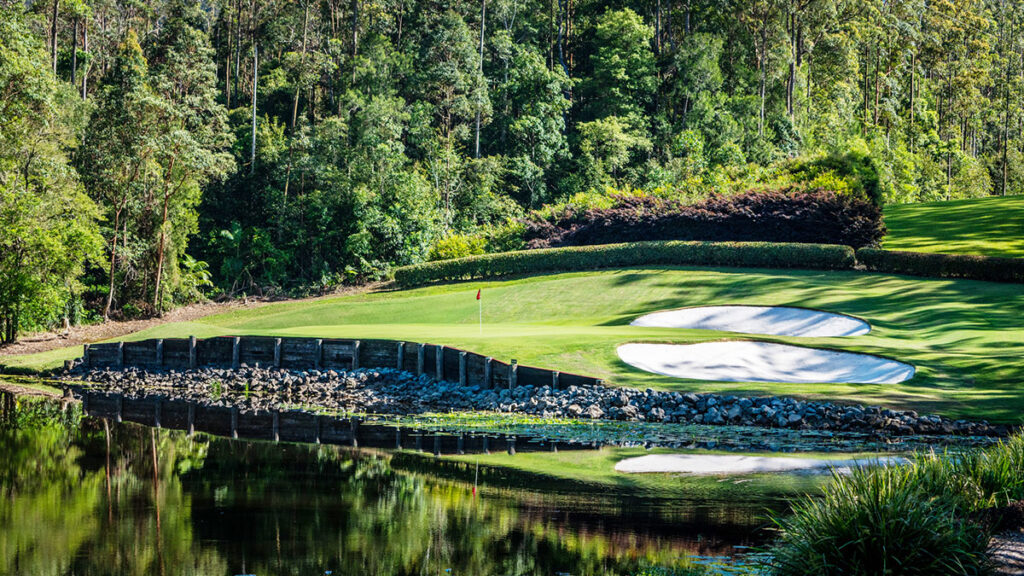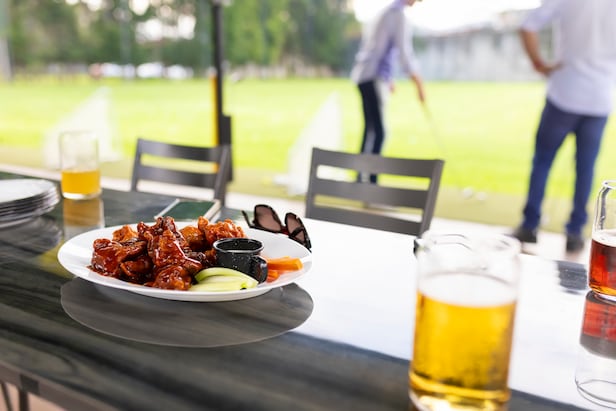Course Review: Bonville Golf Resort – Australian Golf Digest

- by Admin
- August 28, 2024
Expect the unexpected: Bonville is a many-splendoured thing, each hole a work of art that conjures up a fantastic new experience.
Refine. To hone and fine-tune a thing into something special. At Bonville Golf Resort, it describes to perfection the management’s approach to continually and incrementally improving the course and resort facilities.
Built in 1992 and designed by Terry Watson and Ted Stirling, the course is a study in contrasts. I played it for the first time with my husband on a warm winter’s day in late June and we were blown away.
The day before heading out to play, general manager Brad Daymond explained that carts are always required when playing the course because of the long distances between holes. Rain had fallen on the days before we played and so carts were confined to the paths. It was so peaceful to drive though, as the cartpaths meander across natural creeks and through pockets of rainforest that spill from the base of the bordering mountain range. Interestingly, the course was open 364 out of 365 days last year, even though it was a wet year, and the carts were allowed to drive on the course 322 of those days (not just on the cartpaths).
We played on a Thursday, usually the quietest day, and saw only two other people playing, even though there was a full tee sheet. It was pure peace. Toss in the challenge and suspense, and it’s a thrilling experience.
RAISING THE BAR
A key point for the Bonville team is an intense focus on making the golf course as playable as possible. So, a lot of the improvements have been around it being enjoyable for everyone while retaining the unique character of the layout. The management team therefore doesn’t aim to make the course difficult to play. Daymond says it’s all about having a good time.
“The course needs to be challenging but, at the same time, it has to be fair to all players,” he says. “From the relative newcomer to the scratch marker, we create this via the different tees and the varying challenges across the course. So, a bunker that might be in play for the low-handicap player might not be in play for the high handicapper because they can’t reach it off the tee.
“I’ve been here since the course opened 32 years ago and I’ve watched people who might have been in their 20s and 30s then who could power a ball and wanted to play only off the back tees. Those people are now in their 60s and they love coming here – and still have an absolute ball playing off maybe two tees up.”
What truly stunned us, however, was how at every single hole we encountered completely differing environments. No two holes are the same, and that’s from all perspectives – from the layout to the vegetation to the overall beauty. Highlights for me, as a high handicapper, included the fascinating undulations on the par-3 fifth hole, trepidation at the thought of trying to hit a shot over the lake on the par-3 17th (I didn’t make it!) and the exciting 18th.
The day prior, we’d had lunch overlooking the par 5 closing hole and watched in fascination as the members playing in the comp capably and strategically flew their way from an unseen uphill slope in the fairway and onto the steep downhill run. They then had to tackle the water hazard at the bottom, hitting their shots up to the green, which is placed in front of the clubhouse. It was mesmerising to watch players approach the 18th from the comfort of the clubhouse and terrace lawn, which forms an amphitheatre-like setting.
What was interesting for me, though, was that I played pretty well. Having Pacific Dunes in the Port Stephens region of New South Wales as my home course, one that features narrow fairways cut between thick bush on the first nine and water on the back, I found Bonville’s wider fairways, generally on an incline, were more forgiving than expected.

My hubby, a mid-handicapper, enjoyed the course as much as me, saying how much he loved the incredibly diverse layout: “While we played it on a warm winter’s day, you could see how beautiful it would be in spring and autumn. The tees compensate for all player skill levels, whether it be from the Tallowwood (back tees) through to the Flooded Gums (front tees), and right from the first hole it is interesting. The variety continues right to the very end with the test of the 18th. If you overcompensate to make sure you get over the water and onto the green, you can end up with a very challenging downhill putt to a front pin placement.”
The course offers so many more highlights, whether it’s the exhilarating downhill tee shot at the third hole, the round-the-corner drive at the demanding dogleg 12th or any another moment that grabs your attention. While each hole at Bonville is its own isolated piece of serenity, there’s a collective flow to any round there. The first – an opener not to be messed with – asks questions of your golf game from the outset and requires two precise shots to set up a birdie putt. Soon after, though, come a series of more scoreable holes, especially at the par-5 fourth. Featuring a fairway split in half by a ravine, the first section is saddle-shaped and will often ‘save’ a drive that’s veering offline. The second shot is semi-blind and can pose a problem if you don’t get your line right. Do so, though, and you shouldn’t have a lengthy third shot.
The rest of the front nine asks for smart decision-making to set up scoring chances or supreme ball-striking to prevent big numbers. That juxtaposition is highlighted at the seventh and eighth holes, the former a downhill par 5 where even a layup for the second shot should leave a straightforward approach, while the latter is a meaty, long par 3 where only a heroic shot will suffice.
The back nine begins with a potential scoring opportunity at the par-5 10th hole, although it requires some ‘island hopping’, as the fairway is divided into multiple sections with each part split by a rocky stream. Whether attacked in two or approached in three strokes, it’s a chance to start the inward nine in positive fashion. Two holes sure to widen the eyeballs come at the 12th and 13th, a pair of par 4s where taking a combined eight swings is certainly an achievement. The 12th starts from a tee set well above fairway height while the hole bends 90 degrees to the right, asking for a controlled fade (for righties). The long, slender green is protected by a pond on the right, making for two white-knuckle shots. Meanwhile, the 13th scales a significant hillside to a green perched well above fairway level.
The crescendo Bonville builds towards amps up from the 15th hole, a par 4 where it helps to know your distances as you ponder which club to use to stay short of the water that separates the fairway from the green. The 16th has one of the steepest side-sloping fairways in Australian golf, while the closing pair provide two more opportunities for glory, misery or possibly a slice of each. The 17th is a stunning par 3 across a lake with ample bail-out space to the right, while the 18th rises then falls before ascending again to its green in a fitting culmination to the excursion back to the clubhouse.
Overall, Bonville offers a stunning and challenging 18-hole experience set amid lush surroundings and meticulously designed holes that test golfers of all skill levels.

A DESTINATION COURSE
“If you haven’t experienced Bonville Golf Resort, you really need to discover it for yourself,” Daymond says. “The resort is different to anything else you might encounter in Australia – or further afield.”
Bonville is a destination golf course located close to Coffs Harbour, with a strong contingent of golfers visiting from Sydney, Melbourne, South-East Queensland and right across Australia each week. “These golfers come for the whole, amazing experience. When people drive through the front gates, a real feeling of relaxation and excitement sets in. It’s always been that way and will continue to be,” Daymond says.
The course is a great place to play all year round, too. “It’s to do with the mountain range in the background. It’s a fingerling of the Great Dividing Range. It creates its own tropical-style climate here. Golfers from Melbourne (and other southern Australian regions that are cold in winter) come up here to play because they can’t wait to get away from the chill. We’re blessed with our climate and that’s a huge aspect as to why it’s such a successful property. Most golf in winter is played in short sleeves, with a jumper only required at the very start and end of the day. This, combined with summer not being as hot as it is across the Queensland border makes Bonville attractive all year round.
Another feature for all who venture to Bonville is that bookings are well spaced out, creating a feeling of having the golf course to yourself. “We have a limited number of mostly local members and guests staying in-house with only some social golf available,” Daymond says. “Because we know the numbers, we have the right number of staff and the best staff to cater to everyone. This means we can run a very professional ship and can ensure the experience for our visitors is about far more than just the golf course.
“The most popular feedback I receive from guests is about the quality and genuine friendliness of the staff. It’s from the moment you check in when so much care is taken, and our staff explain everything to you, that you know you’re going to a have a great time.”
Package pricing is all-encompassing with golf, cart use, accommodation, a three-course a la carte dinner and breakfast included. The food is a high point and the service impeccable. In fact, the food at the award-winning Flooded Gums restaurant is as good as many fine dining restaurants with plenty of menu options and an award-winning wine list.
“It’s unusual for a course that’s 30-odd years old to still be climbing in the rankings,” Daymond says of Bonville, which improved two spots from its 2022 position. “Normally when a course opens, there’s a lot of fanfare and the course is ranked quite highly to start with as well. Then, as the years go by, courses tend to slip down in the rankings. We’ve avoided that negative momentum because of our ongoing improvements: the little incremental things that keep improving the property and the experience. We just rebuilt the bunkers on hole three and commenced doing the same on hole 11.

“Gardens have continually been added along the way too, and are designed to look good all year round. If you were to come back next year, you’ll see additional gardens with the main feature being that they are made up of colourful shrubs, hedges and bushes that retain their look year-round. The gardens are one of the elements that make Bonville such a unique property. Each hole you play is separate and we have created different environments for each – all with an aim to create a deep sense of peacefulness and the experience of feeling you have it all to yourself.
“To rest on your laurels and on your product is just to really go nowhere. It’s essential to have a growth mindset around what you’re doing. The constant for us is that we have been refining what we do, making improvements, locking them in and then looking at what we can do next.”
What an incredible couple of days at Bonville and I must say, while I haven’t been to Augusta National myself, from what I have seen on television, Bonville seems the nearest comparative course and this makes complete sense when you understand that the brief to the designers of Bonville was to build Australia’s Augusta.
THE DETAILS
Bonville Golf Resort
Where: North Bonville Road, Bonville NSW 2450
Phone: 1300 722 444
Web: bonvillegolf.com.au
The Latest News
-
January 9, 2025Just days left to apply for jobs in Antarctica – Australian Antarctic Program (News 2025)
-
January 9, 2025Australian Open: Destanee Aiava wears vintage dresses as she uses qualifying as ‘fashion runway’
-
January 9, 2025This year’s Australian Open matches to watch, and those to wait for
-
January 9, 2025Tears fall as top ranked Aussie wins grand slam spot
-
January 9, 2025Australian Open 2025: Hady Habib becomes first Lebanese to make Grand Slam main draw in Open Era | Tennis News – Times of India





